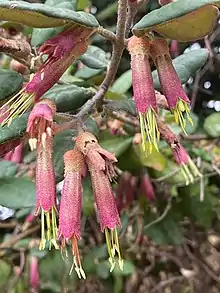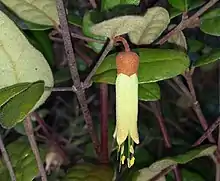Correa lawrenceana
Correa lawrenceana, commonly known as mountain correa,[2] is a species of shrub or small tree of the family Rutaceae and is endemic to Australia. It has elliptical to egg-shaped leaves arranged in opposite pairs and cylindrical, greenish yellow to red flowers usually arranged singly or in groups of up to seven in leaf axils with the stamens protruding beyond the end of the corolla.
| Mountain correa | |
|---|---|
 | |
| Correa lawrenceana var. latrobeana in Yarra Ranges National Park | |
| Scientific classification | |
| Kingdom: | Plantae |
| Clade: | Tracheophytes |
| Clade: | Angiosperms |
| Clade: | Eudicots |
| Clade: | Rosids |
| Order: | Sapindales |
| Family: | Rutaceae |
| Genus: | Correa |
| Species: | C. lawrenceana |
| Binomial name | |
| Correa lawrenceana | |
| Synonyms[1] | |
| |

Description
Correa lawrenceana is a shrub that typically grows to a height of 0.6–9 m (2 ft 0 in–29 ft 6 in), sometimes a tree to 16 m (52 ft), and has branchlets covered with rusty hairs. The leaves are arranged in opposite pairs, elliptical to egg-shaped, 13–120 mm (0.51–4.72 in) long and 7–70 mm (0.28–2.76 in) wide on a petiole up to 16 mm (0.63 in) long. The flowers are arranged singly or in groups of up to seven in leaf axils, rarely on the ends of branchlets, each flower on a pedicel 5–50 mm (0.20–1.97 in) long. The calyx is hemispherical to cup-shaped, 3–10 mm (0.12–0.39 in) long and 4–6 mm (0.16–0.24 in) wide. The corolla is cylindrical, greenish yellow to red with a scaly to velvety surface, 12–50 mm (0.47–1.97 in) long with four short lobes on the end. The stamens project well beyond the end of the corolla. Flowering occurs in spring and sporadically at other times.[2][3][4]
Taxonomy
This species was first described in 1834 by English botanist William Jackson Hooker who gave it the name Correa lawrenciana and published the description in his journal, The Journal of Botany.[5][6] The specific epithet honours Tasmanian botanist Robert William Lawrence (1807-1833) who, together with Ronald Gunn, collected the plant material sent to Hooker.[7] In 1998, Paul Wilson corrected the name to Correa lawrenceana to conform to the Tokyo Code.[8][9]
A subgenus of Correa (Correa subgenus Persistens Othman, Duretto and G.J. Jord.) was formally described in 2011 comprising two species, C. lawrenceana and C. baeuerlenii [10] Unlike other Correa species, C. lawrenceana does not readily form hybrids with other species.[11]
The names of eight varieties are accepted at the Australian Plant Census:
- Correa lawrenceana var. cordifolia Paul G.Wilson,[12] commonly known as pink mountain-correa is distinguished by its broadly elliptic to broadly heart-shaped leaves, and hairy calyx 4–5 mm (0.16–0.20 in) long;[13]
- Correa lawrenceana var. genoensis Paul G.Wilson,[14] commonly known as Genoa River correa is distinguished by its broadly elliptic to broadly heart-shaped leaves and glabrous green calyx 9–12 mm (0.35–0.47 in) long;[9]
- Correa lawrenceana var. glandulifera Paul G.Wilson[15] has elliptic or egg-shaped leaves, a shallow hemispherical calyx about 2 mm (0.079 in) long covered with star-shaped hairs and a yellowish green corolla;[9]
- Correa lawrenceana var. grampiana Paul G.Wilson,[16] commonly known as Grampians mountain-correa, has leathery, broadly elliptical leaves, a calyx covered with woolly rust-coloured hairs and a cylindrical corolla covered with velvety hairs;[9]
- Correa lawrenceana. var. latrobeana (F.Muell. ex Hannaford) Paul G.Wilson[17] is distinguished by its broadly elliptic to broadly heart-shaped leaves, and hairy calyx 4–7 mm (0.16–0.28 in) long;[9]
- Correa lawrenceana Hook. var. lawrenceana[18] has narrow elliptical leaves 20–40 mm (0.79–1.57 in) long and a green corolla;[13]
- Correa lawrenceana var. macrocalyx (Blakely) Paul G.Wilson[19] is similar to var. cordifolia but has a calyx 5–10 mm (0.20–0.39 in) long;[9]
- Correa lawrenceana var. rosea Paul G.Wilson,[20] has narrow elliptical leaves 40–60 mm (1.6–2.4 in) long, a calyx 3–5 mm (0.12–0.20 in) long and a narrow cylindrical corolla that is pink to dull red with green lobes.[9][21][22]
Some varieties grade into each other, and the delineation between them is imprecise.[9]
Distribution and habitat
The species is found in rainforest and sclerophyll forest in Tasmania, Victoria, New South Wales, the Australian Capital Territory and Queensland. Variety cordifolia grows in forest on the coast and tablelands of southern New South Wales, the Australian Capital Territory and far north-eastern Victoria. Variety genoensis is only known from the banks of the Genoa River near the New South Wales - Victoria border. [23][24] Variety glandulifera is found in the mountains from the Gibraltar Range in New South Wales to the McPherson Range in south-eastern Queensland. Variety grampiana grows among rocks in montain areas, mainly in the Grampians. Variety latrobeana is found in south-eastern New South Wales and eastern Victoria. Variety lawrenceana occurs in mountainous areas in Tasmania and the Australian Capital Territory, var. macrocalyx is found in mountainous areas between the Taree and the Illawarra regions in New South Wales and var. rosea is only found in the Snowy Mountains of New South Wales.[9]
Ecology
The flowers are presumed to be pollinated by either birds or bees.[25]
Use in horticulture
Correa lawrenceana is suited to a cool, moist, partly shaded position and is known to tolerate frost and snow. It can be used as a screening plant and will attract honeyeaters to the garden.[26] Plants are easily propagated from cuttings, whereas seed can be difficult.[7]
References
- "Correa lawrenceana". Australian Plant Census. Retrieved 12 July 2020.
- Porteners, Marianne F.; Weston, Peter H. "Correa lawrenceana F.Muell". Royal Botanic Garden Sydney. Retrieved 12 July 2020.
- Wilson, Paul G.; Wilson, Annette J.G. (ed.); Bolton, P.E. (ed.). "Correa lawrenceana". Australian Biological Resources Study, Department of Agriculture, Water and the Environment: Canberra. Retrieved 12 July 2020.CS1 maint: extra text: authors list (link)
- Duretto, Marco F. "Correa lawrenceana". Royal Botanic Gardens Victoria. Retrieved 12 July 2020.
- "Correa lawrenceana". APNI. Retrieved 12 July 2020.
- Hooker, William Jackson (1834). "Contributions Towards a Flora of Van Dieman's Land; from collections sent by R. W. Lawrence, and Ronald Gunn, Esqrs., and by Dr. Scott". The Journal of Botany. 1: 254. Retrieved 12 July 2020.
- "Correa lawrenceana". Australian Native Plants Society (Australia). Retrieved 26 June 2011.
- "Correa lawrenceana". APNI. Retrieved 10 July 2020.
- Wilson, Paul Graham (1998). "Notes on the genus Correa (Rutaceae)". Nuytsia. 12 (1): 96–99. Retrieved 12 July 2020.
- Othman, Raja Nur Ateeka; Gregory J. Jordan; James R. P. Worth; Dorothy A. Steane; Marco F. Duretto (2011). "Phylogeny and infrageneric classification of Correa Andrews (Rutaceae) on the basis of nuclear and chloroplast DNA". Plant Systematics and Evolution. 288 (3): 127–138. doi:10.1007/s00606-010-0315-0. S2CID 22925844.
- Duretto, Marco F. "Rutaceae" (PDF). Flora of Tasmania online. Tasmanian Museum and Art Gallery. Retrieved 26 June 2011.
- "Correa lawrenceana var. cordifolia". Australian Plant Census. Retrieved 12 July 2020.
- Wilson, Paul Graham (1961). "A taxonomic revision of the Genus Correa". Transactions of the Royal Society of South Australia. 85: 44–51. Retrieved 12 July 2020.
- "Correa lawrenceana var. genoensis". Australian Plant Census. Retrieved 12 July 2020.
- "Correa lawrenceana var. glandulifera". Australian Plant Census. Retrieved 12 July 2020.
- "Correa lawrenceana var. grampiana". Australian Plant Census. Retrieved 12 July 2020.
- "Correa lawrenceana var. latrobeana". Australian Plant Census. Retrieved 12 July 2020.
- "Correa lawrenceana var. lawrenceana". Australian Plant Census. Retrieved 12 July 2020.
- "Correa lawrenceana var. macrocalyx". Australian Plant Census. Retrieved 12 July 2020.
- "Correa lawrenceana var. rosea". Australian Plant Census. Retrieved 12 July 2020.
- Costermans, L. (1981). Native Trees and Shrubs of South-eastern Australia. Australia: Rigby. ISBN 978-0727014030.
- Wild Plants of Victoria (database). Viridans Biological Databases & Department of Sustainability and Environment. 2009.
- Porteners, Marianne F.; Weston, Peter H. "Correa lawrenceana var. cordifloia F.Muell". Royal Botanic Garden Sydney. Retrieved 12 July 2020.
- Wilson, Paul G.; Wilson, Annette J.G. (ed.); Bolton, P.E. (ed.). "Correa lawrenceana var. cordifolia". Australian Biological Resources Study, Department of Agriculture, Water and the Environment: Canberra. Retrieved 12 July 2020.CS1 maint: extra text: authors list (link)
- Carter, Oberon; Walsh, Neville. "National Recovery Plan for the Genoa River Correa Correa lawrenceana variety genoensis" (PDF). Australian Government Department of the Environment. Retrieved 12 July 2020.
- Greig, D. (1987). The Australian Gardener's Wildflower Catalogue. Australia: Angus & Robertson. ISBN 978-0-207-15460-7.
| Wikimedia Commons has media related to Correa lawrenceana. |
